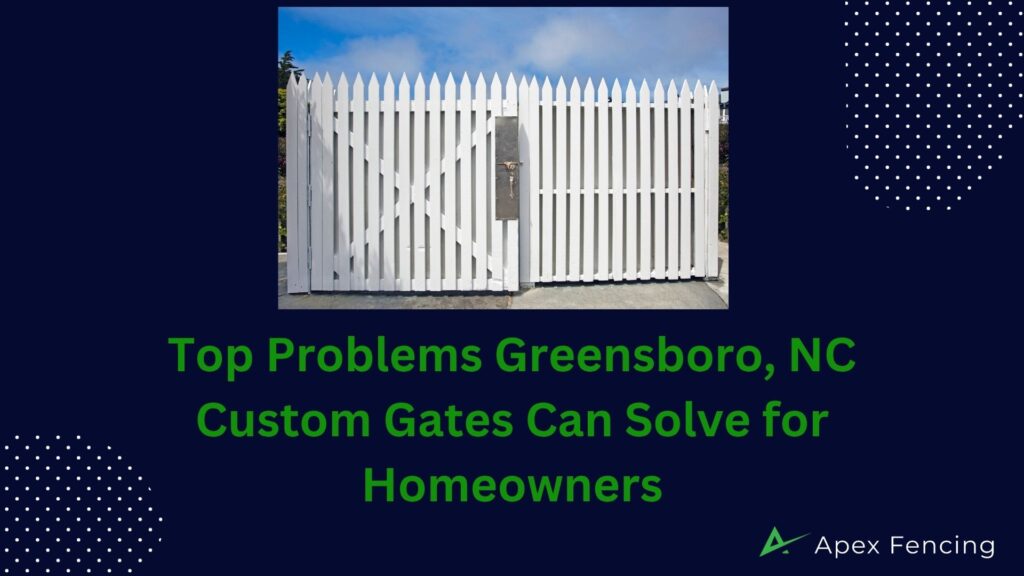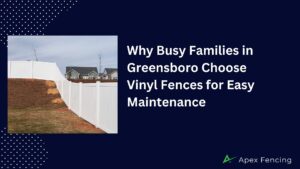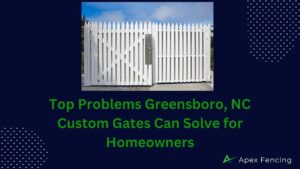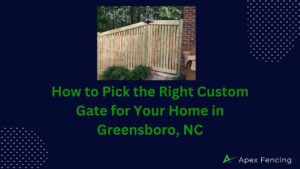Over the years you may face perimeter issues, and a custom gate offers targeted solutions: it boosts curb appeal, strengthens security against unauthorized access, restores privacy, and reduces the risk of accidents on driveways; this guide shows how to assess your needs, choose materials and designs, and maximize both safety and resale value for your Greensboro home.
Key Takeaways:
- Boost curb appeal to make the home more inviting from the street and attract potential buyers.
- Create perceived depth on small or narrow lots so the property feels larger from the sidewalk.
- Add distinctive character with custom designs (e.g., open wrought iron) to make the home stand out and support resale value.
How to Choose the Right Custom Gate for Your Home
Factors to Consider
Assess your driveway width (standard garage openings are 9–12 ft), property slope, and gate operation—swing gates need 12–18 in. clearance per hinge while sliding gates require a level track and stowage area equal to the gate width plus ~18 in. Account for HOA or city codes, desired security features like keyed entry or intercoms, and long-term maintenance budgets; electric operators typically add 10–20% to installation costs. Perceiving how these constraints affect layout prevents expensive rework later.
- Driveway Width
- Operation Type
- Security
- Local Codes
- Budget
Tips for Picking Materials
Match material to climate and upkeep: aluminum resists rust and needs minimal maintenance, wrought iron delivers ornate looks but can corrode without paint touch-ups, and wood provides warmth yet demands staining every 1–3 years in humid areas. Factor in gate weight for hinges and motors—heavier metals require sturdier posts and drives. Perceiving these trade-offs helps you balance style, lifespan, and maintenance to fit your routine.
Expect material and installation costs to vary widely: entry-level aluminum gates often start near $1,000–$2,500, custom wrought iron runs $3,000–$8,000+, and premium wood or composite options typically fall between $2,000–$6,000; automation, concrete footings, and site grading increase labor. Coastal or humid locations accelerate corrosion and rot, so choose protective finishes and warranty terms accordingly. Perceiving these cost and environmental interactions lets you set a realistic budget and maintenance plan.
- Cost Ranges
- Maintenance Cycle
- Environmental Risk
- Installation Needs
- Warranty
How to Enhance Your Home’s Curb Appeal
Pair a custom gate with scaled landscaping, pathway lighting, and coordinated hardware to make your front elevation pop; pedestrian gates are typically about 3 ft wide while driveway gates run 10–16 ft and heights of 4–6 ft are common for curb presence. Choose partially open designs to preserve sightlines and increase perceived lot depth, a detail that influences curb-first impressions for more than half of prospective buyers.
Design Options and Styles
Pick a style that echoes your home: Craftsman houses work well with heavy timber or black wrought iron scrollwork, Colonial facades pair with symmetrical picket or slat gates, and contemporary builds suit horizontal aluminum or steel panels. Function choices—swing, sliding, or cantilever—affect space needs and clearance; sliding gates often solve narrow-driveway constraints while swing gates deliver classic symmetry.
Color and Finish Choices
Metal gates benefit from powder-coated finishes for color stability and corrosion resistance, while wood gates excel with marine-grade stains that protect against UV and humidity; corten steel offers a low-maintenance rust patina if you want an industrial look. Match gate tones to trim or the front door for cohesive curb appeal and choose matte or satin sheens to hide wear.
Consider specific palettes: matte black or charcoal lends timeless contrast and boosts resale, deep bronze warms brick facades, and natural cedar stains highlight grain for rustic homes. Expect to refinish wood every 3–7 years depending on sun exposure, whereas powder-coated metals can retain finish for a decade or more with simple washes; plan color choices around long-term maintenance and neighborhood context.
How Custom Gates Improve Security
A well-designed gate does more than look good; it creates a physical barrier that reduces unauthorized entry and funnels access through controllable points. Add a video intercom, keypad or remote access and motion lighting to turn your entrance into an active security layer. For local installers and reviews, check THE BEST 10 FENCES & GATES in GREENSBORO, NC.
Key Features to Look For
Prioritize features that match your threat profile: choose materials that resist cut-and-climb attacks, electromechanical systems that prevent forced openings, and finishes that withstand corrosion in Greensboro’s humidity. Consider gate height and sightlines—6-ft privacy panels block view, 4-ft decorative gates maintain curb appeal while deterring casual intruders.
- Materials: steel, wrought iron, or aluminum with anti-cut profiles
- Access control: keypads, RF remotes, smart locks, and intercoms
- Automation: hydraulic or electromechanical openers with safety sensors
- Locks: tamper-resistant deadbolts and magnetic locks for gates
- Lighting: motion-activated and timed exterior lights for approach detection
- Finish: weatherproof powder coating or galvanization to prevent rust
- Height & design: 4–6 ft typical ranges depending on privacy vs. visibility needs
Knowing which combination of materials, access control, and automation fits your property helps you balance security, maintenance, and curb appeal.
Installation Best Practices
Set posts in poured concrete footings and use galvanized hardware to avoid premature failure; allow 48–72 hours for concrete to cure before loading gates. Run power to automated systems per local code and include a battery backup for outages. Expect a pro install for a single swing gate to take 1–2 days, plus permit review that can add 1–3 weeks—hire a licensed electrician for electrical work and verify local setback and HOA rules before ordering.
How to Maintain Your Custom Gate
Regular Maintenance Tips
Inspect your gate monthly: check alignment, fasteners, and paint; lubricate moving parts every 6 months with a silicone or lithium grease; for wood gates reseal or stain every 2–3 years; clear debris from tracks and trim vegetation; test automatic safety features quarterly and replace remote batteries annually. Perceiving small noises, increased motor run time, or visible sagging early helps you avoid large repairs and lets a pro address electrical or structural issues before they worsen.
- custom gate inspection — monthly
- lubrication — every 6 months
- hinges & hardware — tighten quarterly
- gate operator tests — quarterly
- rust treatment & touch-up paint — as needed
Signs Your Gate Needs Repair
Watch for uneven movement, sagging more than ½ inch at the latch, grinding noises, slower open/close cycles beyond your normal time, or tripped safety sensors. Visible rust, cracked welds, loose posts, or peeling wood finish indicate structural decline. For automated systems, repeated breaker trips or a motor that overheats during a single cycle are red flags you should document before calling a technician.
For swing gates, a vertical drop exceeding 1 inch usually means worn hinge pins or shifted posts; options include hinge rebuilds or post reinforcement. Sliding gates that jump rollers, deviate more than ¼ inch on the track, or stall after 20–30 seconds often need roller replacement or track leveling. Stop using the gate and contact a licensed technician immediately if you see exposed wiring, sparks, or failure of safety stops.
How to Increase Property Value with Custom Gates
Adding a custom gate directly affects curb appeal and perceived value by framing your property and signaling quality finishes. You can choose an open wrought-iron style to add depth or a solid wood gate for privacy; both can shift buyer perception. Upgrades that combine design with security — like an elegant gate plus an intercom — often translate into a stronger listing and higher offers.
Market Trends for Custom Gates
You’ll see rising preference for automated gates with smart intercoms, low-maintenance materials like powder-coated aluminum, and mixed-material designs (wood + metal) that match modern homes. Customization demand is growing as buyers look for distinct curb appeal; landscape architects and agents report more requests for integrated lighting and solar operators to cut long-term costs.
ROI on Custom Gate Investments
Typical custom gate projects range from roughly $2,000–$20,000 depending on materials and automation, and exterior upgrades often recoup a significant portion of cost at sale. Cost vs. Value analyses and broker feedback suggest many exterior enhancements return about 50–80% of investment, with added value from improved showing photos and buyer interest.
For a concrete example, a $8,000 automated wrought-iron gate that improves curb appeal and security can sway offers and reduce negotiation leverage for buyers; some agents estimate a post-upgrade sale premium of $3,000–$12,000 depending on neighborhood. You should also factor ongoing benefits: automated gates can shorten days on market and enhance safety, which often converts to higher effective ROI when you consider faster sales and fewer price concessions.
How to Integrate Technology into Your Gate System
Choose a smart opener with Wi‑Fi/2.4 GHz or Ethernet, add an IP camera (1080p, IP66) and an intercom that links to your phone; integrate with Alexa, Google or HomeKit for voice and automation. Combine access control (keypad, RFID, license-plate recognition) with safety sensors and a 12V battery backup to keep your gate operational during outages. Hire a certified installer to ensure wiring, grounding and UL 325 compliance.
Smart Gate Features
Use a keypad that supports up to 250 user codes, Bluetooth geofencing to open gates within 50–100 m, and RFID tags (1–3 ft read range) for hands‑free entry. Add license‑plate recognition for guests, timed access windows for contractors, and smartphone apps with real‑time alerts and video clips. Over‑the‑air firmware updates and cloud logging help you track access history and quickly revoke credentials.
Safety and Convenience Enhancements
Install dual photoelectric beams and edge sensors with force detection to stop and reverse motion on contact; set auto‑close delays from 5–30 seconds to prevent tailgating. Add mechanical stops, an emergency manual release with a keyed cylinder, and a UPS or 12V backup battery so your gate remains secure during power failures. Test reversal response and sensor alignment after any adjustment.
Follow manufacturer torque and speed settings and verify UL 325‑recommended force limits during commissioning; set motor torque to the minimum that reliably moves the gate, and calibrate obstacle detection so false triggers drop below 5–10% of cycles. Position beams 4–10 inches above grade to detect pedestrians, place cameras to cover both approaches, and schedule monthly tests of backup power and remote‑access credentials to keep your system reliable.
Final Words
Custom gates solve many challenges for Greensboro homeowner, from boosting curb appeal and property value to enhancing privacy, controlling driveway access, and strengthening security. The right design—swinging, sliding, or automated—depends on your lot size, slope, and daily needs. With durable materials like aluminum, steel, or wrought iron, and smart features such as intercoms and remote access, a custom gate provides long-term safety and convenience while improving your home’s first impression.
👉 Looking to install a custom gate in Greensboro, NC? Trust Apex Fencing for expert design, quality craftsmanship, and professional installation that ensures your gate is both functional and beautiful.
📞 Contact Apex Fencing today for a free consultation and discover how the right gate can solve problems and add value to your property.







